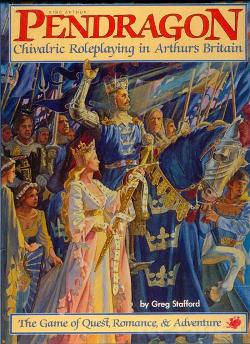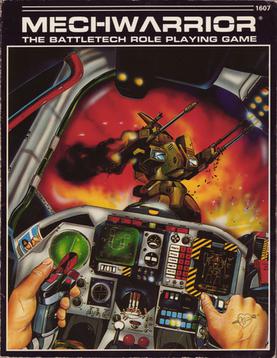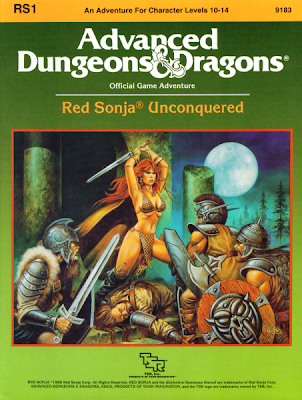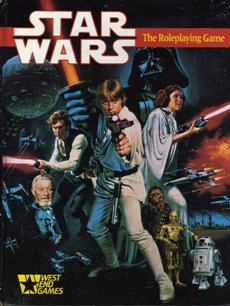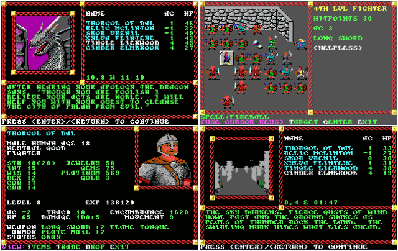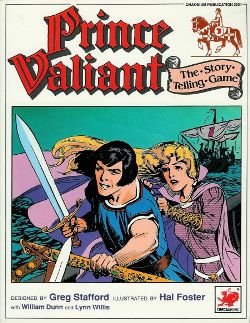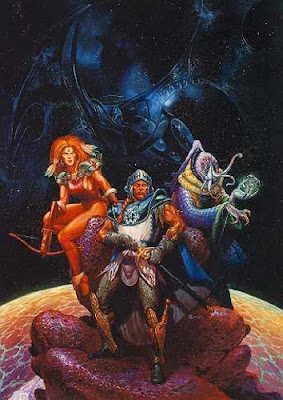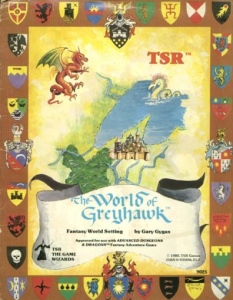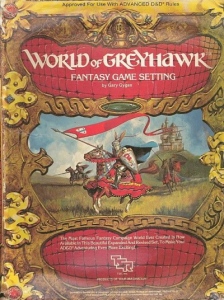Continued from: http://www.enworld.org/forum/genera...-history-d-d-some-other-rpgs-1967-1979-a.html
1980
The Fantasy Trip [/U]by Jackson (of Texas) published by MetaGaming. Based on minigames Melee and Wizard, TFT included flexible, non-random, character creation for its two classes, three stats (Strength, Dexterity, and IQ), and combat played out on a hex-grid. MetaGaming founder Howard Thompson and Steve Jackson quickly part ways, with Thompson deriding TFT’s “complexity”. Jackson would successfully found Steve Jackson Games and release Car Wars that year, an autodueling game that would do for armed and armored cars what Melee did for fantasy fighters.
Arms Law by Fischer, Fenlon, and Charlton published by Iron Crown Enterprises. A highly detailed chart driven supplement that could be used to replace the combat system in D&D, or other games. In the coming years it will be joined by Spell Law—2000 spells—Claw Law, Character Law, etc. These will ultimately be combined into the Rolemaster game system.
The Morrow Project by Dockery, Sadler, and Tucholka published by Timeline games. A first RPG focused on detailed modern combat, player charterers are frozen soldiers awakened 150 years after WWIII.
Top Secret by Rasmussen and Hammack published by TSR. The espionage RPG includes vestigial classes, percentile based attributes and skills and introduces “Fame and Fortune” points which characters can use to get out of otherwise deadly situations.

Deities and Demigods by Ward with Kuntz and Schick published by TSR. A total revamp of Gods, Demigods and Heroes, this book would include information for several historical pantheons (Greek, Norse, Egyptian, Sumerian, etc) plus Arthurian Heroes, and pantheons drawn from Fritz Lieber’s Newhon, Michael Moorcock’s Elric stories, and H.P. Lovecraft’s (and others) Cthulhu mythos. It would also introduce new “non-human” gods that would be some of the first deities created specifically for D&D. Entries were presented in Monster Manual style, implying that gods should serve as high level opponents. While there was an agreement with Chaosium to include the Cthulhu and Elric material, these were dropped from later printings.
World of Greyhawk by Gygax published by TSR. An expanded version of Gary Gygax’s home campaign setting, presented concisely and allowing DMs ample scope for expansion and modification. A mix of the quasi historical and purely fantastic, this is the setting for most early AD&D adventures.
…These include Gygax’s S2 Expedition to the Barrier Peaks, which allows the PCs to find a crashed spaceship and Sutherland’s and Gygax’s Q1 Queen of the Demonweb Pits, which allows the PCs to travel to other planes and fight a demon goddess. Others include 3 adopted from tournament play: A1 Slave Pits of the Undercity by Cook, C1 The Hidden Shrine of Tamoachan by Johnson and Leason and C2 The Ghost Tower of Inverness by Hammack. All have pre-generated characters and “boxed text” that the DM could use to quickly describe an area. Tamoachan also comes with a book of illustrations and impractically small encounter/battle maps.

Zork by Anderson, Blank, Daniels, and Lebling is released by Infocom. Originally named Dungeon, until receiving a notice of trademark violation from TSR, in this text based video game the player explores a sprawling labyrinth and ultimately earns the title Dungeon Master. It also includes grues. Ultima I by Garriott (aka Lord British) is released by Origin Systems and includes dungeon crawling and characters defined by ability scores, classes, level and race, one choice of which is Bobbit. It does however also have space combat. Trubshaw and Bartle at Essex University develop MUD (multi-user dungeon), and make it available on the ARPANet, the predecessor to the internet.
The Role-Playing Game Association is founded by Mentzer and TSR to facilitate tournament play of D&D and later other TSR games.
1981
Call of Cthulhu by Peterson et al published by Chaosium. A masterful combination of 1920’s cosmic horror and innovative enough mechanics, CoC allows for relatively “normal” characters to become embroiled in the world of Lovecraft’s Cthulhu mythos, often disastrously so. CoC is based on Perrin and Stafford’s Basic Roleplaying system, which was also included in the box. This year Chaosium would also publish Stormbringer; based on Michael Moorcock’s Elric stories and also using the BRP system.

Champions by Mac Donald and Peterson published by Hero Games. Introducing a point buy system of advantages and disadvantages and “effect based” powers that allowed for the creation of highly custom and genre appropriate characters, Champions continues the trend to more detailed genre-simulation while becoming the most popular supers game.
Aftermath! by Charrette and Hume published by Fantasy Games Unlimited. A more complex and “realistic” take on the post apocalyptic struggle for survival. With truly detailed firearm rules and a number of flow charts and tables sometimes needing more advanced mathematics to resolve.
The Mechaniod Invasion by Siesmbieda published by Palladium Books. The PCs are colonists on another planet attacked by cybernetic aliens. Both an early “mecha” game and the debut of the class-level anything goes D&D variant system that will be expanded in latter Palladium products. No advanced math required.
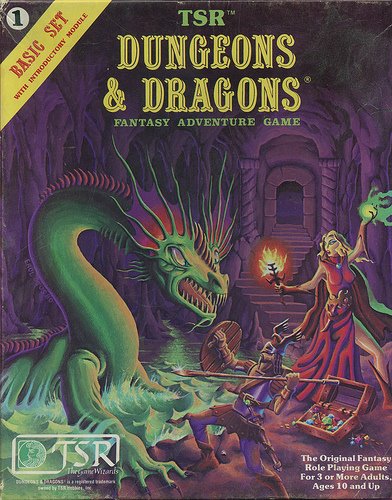
Dungeons and Dragons Basic Rules Set by Moldvay and Expert Rules Set by Cook with Moldvay published by TSR. A streamlined presentation of original Dungeons and Dragons, the two box sets would now become a free-standing game, (legally) distinct from AD&D. While part of TSRs strategy to move from D&D the dorm to junior high, the game is complete, usable by adults (albeit often with other versions of D&D), and, with their Erol Otus covers, retaines the games weird sword and sorcery vibe. It would clarify “race as class” implied in Holmes Basic and place more explicit emphasis on wilderness exploration and founding settlements. B/X D&D would also have its own unique “Known World” sketched out in X1 Isle of Dread , the expert sets companion module.
Fiend Folio edited by Turnbull published by TSR. Originally to be published by D&D UK Licensee Games Workshop, the Folio would reprint a number of monsters first published in White Dwarf, together with some from various D&D modules, and some submitted to Dwarf but not published. The book, which introduces the Githyanki, Slaad, and Flumph to the world, is criticized in two reviews in Dragon, to which Trunbull writes a rebuttal. Ed Greenwood’s is particularly critical.

TSR publishes 9 more (A)D&D modules. Together with X1, Cook also does I1 Dwellers in the Forbidden City, which introduces the yuan ti snake men. The new Expert set is also supported by Moldvay’s ambitious X2 Castle Amber. The slaver series continues with A2 Secrets of the Slavers Stockade by Johnson with Moldvay, A3 Assualt on the Aerie of the Slave Lords by Hammock, and A4 in the Dungeons of the Slave Lords by Schick. Two adventures for new characters featuring nearby villages are also released: L1 the Secrets of Bone Hill by Lafoka and U1 Sinister Secrets of Saltmarsh by Browne with Turnball (and considered British, like the Folio). This leaves…
B3 Palace of the Silver Princess by Wells (and Moldvay) published by TSR (twice). Jean Well’s original—the first product by a woman at TSR—is quickly recalled and replaced by a substantially revised module. The original’s art (which caricatures Gygax and other TSR staff) is considered in poor taste, the approach out of step with other products (fill in the blanks monsters as in B1) and it is basically considered just too odd as is.

TSR now has 200 employees and still expanding. It replaces (some of) its typewriters with a computer and terminals.
The Polyhedron newsletter is published by the RPGA.
Mazes and Monsters by Jaffa published by Delacorte Press. A quickly written highly fictionalized account of the James D. Egbert “steam tunnel incident”, the book would equate RPGs with mental illness and violent behavior. It is joined by Hobgoblin by Coyne and a growing undercurrent of hysteria.
1982
Behind Enemy Lines by Keith et al published by FASA. Traveler (for which FASA published supplements) derived rules for WWII combat roleplaying. Its joined by Recon by Martin, where characters are Vietnam era special forces, and (in 83) FGUs contemporary Merc by Bader, Sangee, and Mark.
Star Trek: The Role Playing Game by McLimore, Poehlein, and Tepool published by FASA. Characters are Star Fleet officers exploring strange new worlds. Star Trek uses a variant of the now popular percentile based skill system with Traveler influence in character generation and includes rules for psionics and spaceship combat that allows the whole party to contribute. The game draws heavily from the first and animated series, and makes great effort to fill in various gaps in the Star Trek universe, briefly creating its own Star Trek “canon”.
Star Frontiers by Winter et al published by TSR. Action oriented and light in tone—rubbery amoeboids and gliding ape men as PC races, worm things as the main enemy—and with a now ubiquitous percentile skill system, the game is positioned to tap into TSR broad and every younger target demographic. However this is somewhat undermined by overly complex design by committee. The Knight Hawks supplement space combat rules become popular as a free standing war/board game.

Gangbusters by Krebs and Acres published by TSR. Focused on crime and corruption in the prohibition era, the game is notable for relatively concise and complete rules (with percentile skills) and individualized experience points for achieving career specific goals. In a similar 20’s/30’s pulp vein Daredevils by FGU stalwarts Charrette and Hume adds to that companies large and growing list of RPGs.
Worlds of Wonder by Perrin published by Chaosium. Building on Chaosium’s Basic Role-Playing, this includes three short adaptations emphasizing BRP universal potential: fantasy, supers, and science fiction; and a setting where the three meet.
A Campaign and Adventurers Guidebook for Middle Earth by Fenlon published by Iron Crown Enterprises. A generic supplement for any fantasy RPG (including D&D) with a very high quality poster map, this is the first Lord of the Rings RPG product. (ICE was the first to ask permission). ICE also starts publishing Middle Earth supplements for Rolemaster, though these would also be rules light (and hence usable with D&D). ICE generally avoids direct overlap with the Lord of the Rings, setting the supplements centuries earlier and often in areas distant from those focused on in the trilogy.
Fantasy Wargamming by Galloway published by Stein and Day/Doubleday. Distributed in book stores and by the Science Fiction Book Club, this is another “realistic” fantasy RPG; it includes possibly useful background material on medieval Europe and the rules of a barely playable RPG. FGU also adds the class and money-less Sword Bearer and SPI the complex Dragonquest to the fantasy pile.

TSR publishes a modest 8 adventures for its two D&Ds: B4 The Lost City, another ambitious Moldvay creation; S4 Lost Caverns of Tsojcanth and WG 4 The Forgotten Temple of Tharizdun , two linked adventures by Gygax, the first being the revised version of one of the first modules (from 76) that would introduce the Demonicon of Iggwiz; the second would introduce its namesake god, originally created by Kuntz. The others are Saltmarsh sequel U2 Danger at Dunnwater by Browne and Turnball, the not directly connected N1 Against the Cult of the Reptile God by Niles and I2 Tomb of the Lizard King by Acres, and the mystery X3 Curse of Xanathon also by Niles;….
…and Pharaoh by Hickman and Hickman. Originally written and self published by husband and wife Tracy and Laura in ‘77, the Egyptian themed adventure with its strong mix of atmosphere, story, and exploration was one of a series of adventures, and ideas, the Hickmans brought with them to TSR.
Mayfair Games issues “AD&D compatible” adventures in the Role Aids line, starting with half a dozen in 1982. The line would be prolific with dozens of products, but would not get an official license from TSR, in spite of Gygax apparently suggesting they receive one.
Dungeon of Dread by Estes published by TSR. The first of 36 books published in the Endless Quest line over the next 5 years, these are similar to Bantam’s Choose Your Own Adventure series, but longer, with somewhat more detailed characters, and of course D&D specific references.
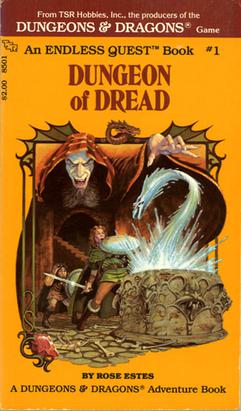
Warlock of Firetop Mountain by Jackson (of England) and Livingstone published by Puffin. The first of 59 books in what would become the highly popular Fighting Fantasy Series, the Games Workshops founders added simple character stats and dice rolling to the Choose Your Own Adventure approach.
Dungeons and Dragons is sold in 20 countries and is translated into French, the first of 16 languages (along with English) it would be sold in. TSR sales double, again, to $20 million (of which roughly $16 million is D&D), and it now has over 300 employees. As it turns out, this would be the most it would have for some time.
Mazes and Monsters is made into a TV movie starring Tom Hanks. His character is driven crazy by the game, forever believing that he is his cleric, Pardeux.
YouTube - Mazes and Monsters - Tom Hanks Freaks Out
In June, Irving Lee “Bink” Pulling kills himself. According to his mother Patricia, “hours after a D&D curse was placed on him during a game conducted at his local high school”. She sues the principal and then latter TSR over the death of her son.
1983
Gary Gygax finds himself in Hollywood, president of TSR (later D&D) Entertainment. Kevin and Brian Blume are left in charge at HQ in Lake Geneva.
A January New York Times article speculates that D&D may become the game of the 1980s, in the way that Monopoly was the game of the 1930s.
James Bond by Klug et al published by Victory Games. Appropriately action oriented take on the books and movies. Includes rules for chases, gambling, and seduction. Tasks are resolved with a "quality results table"; the GM sets difficulty, and the result of a single percentile die roll determines how successful the action is. Bond is joined this year by Stackpole’s Mercenaries, Spies, Private Eyes, published by Flying Buffalo (and bearing clear vestiges of Tunnels and Trolls) and Hero Game’s Espionage by MacDonald and Peterson.

Lords of Creation by Moldvay published by Avalon Hill. This rules-simple RPG by the D&D Basic Set designer is a first by the war game publisher and allows powerful characters to travel through time, space, and genres, or experience them all mixed together. Avalon Hill also releases the complex fantasy RPG Powers and Perils by Snider.
Harn by Crosby published by Columbia Games. A “real fantasy world’ for “any” fantasy rpg, it is later supported by its own involved system, 86’s Harnmaster, as is the style of the time. It is joined on the ever growing fantasy RPG pile by the Palladium Role-playing Game by Siembieda, which bucks the trend towards detailed realism (though it does have a parry role), hewing closer to D&D in substance and tone and outlasting many contemporary games.
Dungeons and Dragons Basic Rules Set by Mentzer and Expert Rules Set revised by Mentzer published by TSR. The third basic set keeps the same rules but thoroughly revises presentation to make them more accessible to an ever younger target audience. The Keep on the Borderlands is replaced by a solo scenario. The Expert set also receives a mild update.

Monster Manual II by Gygax published by TSR. The third book of monsters for (A)D&D would reprint monsters from Dragon magazine and various modules including Dwellers in the Forbidden City (…Yuan-Ti…) and Lost Caverns of Tsojcanth (…Behir…) and introduce Devas, Mondrons, Duergar, and several others. Gygax also penns the World of Greyhawk Fantasy Game Setting, this box set is a much expanded version of 1980's folio, incorporating Greyhawk Deities and other material originally published in Dragon as well as some new details on the Flanaess.
TSR publishes 15 (A)D&D adventures, including flashbacks to the original Castle Greyhawk in Gygax’s Alice inspired EX1 Dungeonland and EX2 Land Beyond the Magic Mirror ; Bone Hill sequel and murder mystery L2 Assasin’s Knot by Lakofka; Saltmarsh finale U3 The Final Enemy by Brown and Turnbull and Uk1 Beyond the Crystal Cave also by Brown (with Kirby and Morris) another distinct “British” module with an emphasis on problem solving over fighting; Niles’ intro adventure B5 Horror on the Hill ; Cook’s X4 Master of the Desert Nomads and its sequel X5 Temple of Death; and 3 intended for solo or one on one play (MSOL1 Blizzard Pass, MSOL2 Maze of the Riddling Minotaur, and O1 The Gem and the Staff). Hickman’s Pharaoh sequels I4 Oasis of the White Palm and I5 Lost Tomb of Martek are also published, as is…

I6 Ravenloft. Another adventure that Hickman and Hickman would bring to TSR, the Gothic Horror inspired Ravenloft is a fusion of traditional dungeon, story, and theme that includes other novel elements, such as 3D maps of the castle and a fortune telling that randomly determined key parts of the adventure.
Gygax’s Hollywood adventures pay off when The Dungeons & Dragons Cartoon debuts September 17 on CBS. With 27 episodes over 3 seasons, the cartoon features the adventures of kids pulled from our world into the D&D world: Hank the Ranger, Sheila the Thief, Presto the Magician, Eric the Cavalier, Diana the Acrobat, and Bobby the Barbarian. There they meet Uni the unicorn and the kindly but enigmatic Dungeon Master, do battle with Venger and Tiamat, solve a range of problems, and get chased by orcs. The cartoon leads its time slot for two years but is cited as one of the most violent shows on children’s television.
The cartoon also spawns over a hundred licenses, including D&D toys made by LJN.
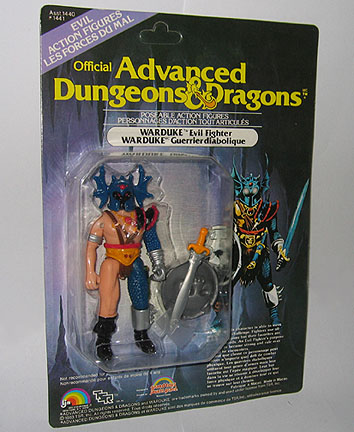
Strong game sales and licensing lead to…financial failure as the Blume brothers over diversify. TSR own attempts to manufacture toys, miniatures, and needlecraft kits (yes, that’s right) lead to multi-million dollar losses. TSR responds with what would become the first of regular and frequent layoffs by the company that makes D&D. Two waves of cuts would reduce the staff by more than half, to under 150 employees.
1984
Over 40 new and revised RPGs are released and distributed nationally by catalog and through a burgeoning network of hobby game stores. These include those of the new Pacesetter games, one of a series of companies founded by former TSR employees: the horror game Chill, the Star Wars inspired Starace, and the time travel game Timemaster. The games by Acres, Sanchez, Spiegle, Hayday, Smith, and Williams, are light on rules and tone and would follow the lead of James Bond in using a single action table to resolve various tasks.
Other less serious releases include Toon by Costikyan and Spector and published by Steve Jackson Games and Paranoia, also by Costikyan and Gelber, Goldberg and Rolston and published by new to RPGs West End Games. The first allows for the play of immortal and zany cartoon characters; the second highly mortal trouble shooters looking for commie mutant scum who happen to be commie mutant scum. Fortunately when your character dies, his clone is waiting to take his commie mutant scum place.
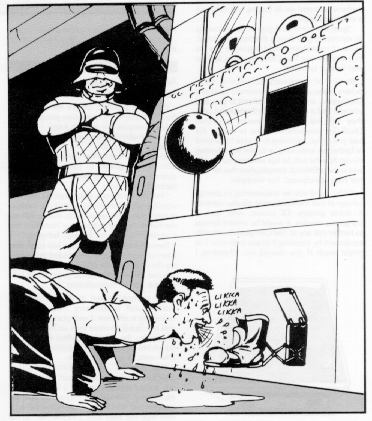
Twilight 2000 by Chadwick with Astell, Harsham, and Wiseman published by GDW. Not particularly light or light hearted, this game by the Traveler publisher quickly establishes itself as the premier military RPG and is helped by its premise of limited apocalypse—Central Europe after (or technically during) a low grade nuclear exchange and conventional war—that allows for the use of modern heavy weapons with the freedom that RPGers tend to prefer.
Middle Earth Role Playing by Charlton with Ruemmler, Britton, and Fenlon published by ICE. MERP is a free standing game using a light version of the Rolemaster rules (though not light enough for some given the source material). A top-seller that is translated into 12 languages; as with ICE’s earlier LotR offerings, the game is set in a period other then the trilogy and supplements (about 21 not including adventures) are rules-light enough to be used with that other FRPG.
Das Schwarze Auge (The Dark Eye) by Kiesow published by Schmidt Spiel & Freizeit GmbH. The fantasy RPG rapidly becomes the biggest selling RPG in Germany and will be translated into Dutch, French, and Italian (It will be a few editions before an English translation is released). This edition has a complexity level slightly above that of Basic D&D: it grows rapidly with each subsequent iteration. One novel mechanic is spell casting, which requires the player to recite memorized formulas.
TSR enters the market for licensed properties with Marvel Super Heroes by Grub and Winter and The Adventures of Indiana Jones by Cook. Both are rules light games and neither really supports character creation: players are expected to play familiar fictional characters. Marvel Super Heroes, which also has a universal table called a Universal Table, becomes a popular alternative to Champions. Expanded rules, including for character generation, are presented in a ’86 Advanced Set. Indiana Jones is neither as successful nor enduring, and becomes most notable for its connection to the “Dianna Jones” game award trophy: a solid plastic pyramid that encase some burnt remains of the game that survived the destruction of unsold copies by TSR UK at the termination of the license.

The Dungeons and Dragons Companion Set by Mentzer released by TSR. This goes beyond the Expert set with rules for characters 15-25. It includes PC castle and domain management, tournaments, and the influential War Machine that allows for the resolution of mass battles with a few rolls of the dice.
TSR publishes 26 modules for (A)D&D, including more licensed properties: CB1 Conan Unchained by Cook and CB2 Conan against the Darkness by Rolston, with rules for Hyborian Age play and stats for Conan and some friends. WG5 Mordenkainen's Fantastic Adventure by Kuntz and Gygax, taken from Kuntz’s Maure Castle were Gygax’s wizard did some adventuring, is another module harkening back to the early days of D&D. N2 The Forest Oracle by Smith is arguable the worst adventure ever produced by TSR, though it does include a yeti.
4 of the adventures— Dl1 Dragons of Despair , Dl2 Dragons of Flame , DL 3Dragons of Hope , and DL4 Dragons of Desolation —are the outcome of yet another one of the ideas the Hickmans brought with them to TSR. Dragonlance, led by Tracy Hickman and including Dobson, Grubb, Johnson, Moore, Niles, and Williams, was a project supported by TSRs marketing department to bring more dragons to Dungeons & Dragons. Under the codename Project Overlord a new D&D world and series of linked adventures are developed that place more emphasis on participating in a high fantasy story, with the players encouraged to play pre-generated characters and the DM encouraged to move them through a number of predetermined milestones, sometimes regardless of the players’ actions.

The adventures would also be tied to a series of novels ultimately written by Tracy Hickman and Margaret Weis. Originally seen as supporting the first set of modules, Dragons of Autumn Twilight sells in the millions, is translated into a number of languages, and helps to spawn hundreds of games, books and licensed Dragonlance products.
When her case against TSR over the death of her son is thrown out of court, Patricia Pulling founds BADD (Bothered About Dungeons and Dragons) and spends the following years as an “expert” on the occult linking RPGs to real demons and devils. The occult link is accepted in parts of the religious community, and makes it into a Chick Tract, Dangerous Dungeons
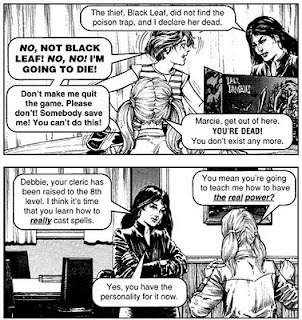
DragonRaid by Wulf published by Adventures for Christ. The PCs are LigthRaiders who face inner conflicts and use the quotation of Bible scripture to fight dragons and other sinning monsters in the world of EdenAgain. They get to use a crystal d10 vs. the evil doing non-believers black d8. Combat is fairly detailed—including critical hits—and is used to subdue those that can be saved and slay “monsters” that have clear real life equivalents. Pulling et al denounce it as a RPG and hence innately bad. It remains in print.
The Dungeon Master: The Disappearance of James Dallas Egbert III by Dear reveals that the detective’s early conflation of D&D, steam tunnels, and Egbert’s death was just that. Its publication does nothing to deter Pulling and her growing number of fellow believers.
Dragon Magazine, edited by Mohan and published by TSR reaches its peak circulation of 118,000 (versus 60,000 in 82 and 20,000 in 1980)
While overall RPG sales begin to plateau after years of rapid growth, hobby gaming remains vibrant, with both old and new games sold through the network of stores built largely off the success of D&D. These include newly released Battletech from FASA, Supremacy from Supremacy Games, and Axis and Allies from Milton Bradely. Games Workshop’s Warhammer Fantasy Battles (1st ed in 83, 2nd ed in 84), would return to the roots of roleplaying with its rules and figures for fantasy miniature warfare.

With all the success of D&D as a brand and revenue source, TSR’s debt keeps growing and the company is forced to layoff 35% more staff, reducing the total to less then 100.
Gary Gygax is again the CEO of TSR, relieving Kevin Blume of the position. He is looking to prevent out and out bankruptcy. He brings someone he met in Hollywood with him: A new investor and manager, and non-gamer, Lorraine Williams is heiress to the “Buck Rogers” fortune.
1980
The Fantasy Trip [/U]by Jackson (of Texas) published by MetaGaming. Based on minigames Melee and Wizard, TFT included flexible, non-random, character creation for its two classes, three stats (Strength, Dexterity, and IQ), and combat played out on a hex-grid. MetaGaming founder Howard Thompson and Steve Jackson quickly part ways, with Thompson deriding TFT’s “complexity”. Jackson would successfully found Steve Jackson Games and release Car Wars that year, an autodueling game that would do for armed and armored cars what Melee did for fantasy fighters.
Arms Law by Fischer, Fenlon, and Charlton published by Iron Crown Enterprises. A highly detailed chart driven supplement that could be used to replace the combat system in D&D, or other games. In the coming years it will be joined by Spell Law—2000 spells—Claw Law, Character Law, etc. These will ultimately be combined into the Rolemaster game system.
The Morrow Project by Dockery, Sadler, and Tucholka published by Timeline games. A first RPG focused on detailed modern combat, player charterers are frozen soldiers awakened 150 years after WWIII.
Top Secret by Rasmussen and Hammack published by TSR. The espionage RPG includes vestigial classes, percentile based attributes and skills and introduces “Fame and Fortune” points which characters can use to get out of otherwise deadly situations.

Deities and Demigods by Ward with Kuntz and Schick published by TSR. A total revamp of Gods, Demigods and Heroes, this book would include information for several historical pantheons (Greek, Norse, Egyptian, Sumerian, etc) plus Arthurian Heroes, and pantheons drawn from Fritz Lieber’s Newhon, Michael Moorcock’s Elric stories, and H.P. Lovecraft’s (and others) Cthulhu mythos. It would also introduce new “non-human” gods that would be some of the first deities created specifically for D&D. Entries were presented in Monster Manual style, implying that gods should serve as high level opponents. While there was an agreement with Chaosium to include the Cthulhu and Elric material, these were dropped from later printings.
World of Greyhawk by Gygax published by TSR. An expanded version of Gary Gygax’s home campaign setting, presented concisely and allowing DMs ample scope for expansion and modification. A mix of the quasi historical and purely fantastic, this is the setting for most early AD&D adventures.
…These include Gygax’s S2 Expedition to the Barrier Peaks, which allows the PCs to find a crashed spaceship and Sutherland’s and Gygax’s Q1 Queen of the Demonweb Pits, which allows the PCs to travel to other planes and fight a demon goddess. Others include 3 adopted from tournament play: A1 Slave Pits of the Undercity by Cook, C1 The Hidden Shrine of Tamoachan by Johnson and Leason and C2 The Ghost Tower of Inverness by Hammack. All have pre-generated characters and “boxed text” that the DM could use to quickly describe an area. Tamoachan also comes with a book of illustrations and impractically small encounter/battle maps.

Zork by Anderson, Blank, Daniels, and Lebling is released by Infocom. Originally named Dungeon, until receiving a notice of trademark violation from TSR, in this text based video game the player explores a sprawling labyrinth and ultimately earns the title Dungeon Master. It also includes grues. Ultima I by Garriott (aka Lord British) is released by Origin Systems and includes dungeon crawling and characters defined by ability scores, classes, level and race, one choice of which is Bobbit. It does however also have space combat. Trubshaw and Bartle at Essex University develop MUD (multi-user dungeon), and make it available on the ARPANet, the predecessor to the internet.
The Role-Playing Game Association is founded by Mentzer and TSR to facilitate tournament play of D&D and later other TSR games.
1981
Call of Cthulhu by Peterson et al published by Chaosium. A masterful combination of 1920’s cosmic horror and innovative enough mechanics, CoC allows for relatively “normal” characters to become embroiled in the world of Lovecraft’s Cthulhu mythos, often disastrously so. CoC is based on Perrin and Stafford’s Basic Roleplaying system, which was also included in the box. This year Chaosium would also publish Stormbringer; based on Michael Moorcock’s Elric stories and also using the BRP system.

Champions by Mac Donald and Peterson published by Hero Games. Introducing a point buy system of advantages and disadvantages and “effect based” powers that allowed for the creation of highly custom and genre appropriate characters, Champions continues the trend to more detailed genre-simulation while becoming the most popular supers game.
Aftermath! by Charrette and Hume published by Fantasy Games Unlimited. A more complex and “realistic” take on the post apocalyptic struggle for survival. With truly detailed firearm rules and a number of flow charts and tables sometimes needing more advanced mathematics to resolve.
The Mechaniod Invasion by Siesmbieda published by Palladium Books. The PCs are colonists on another planet attacked by cybernetic aliens. Both an early “mecha” game and the debut of the class-level anything goes D&D variant system that will be expanded in latter Palladium products. No advanced math required.

Dungeons and Dragons Basic Rules Set by Moldvay and Expert Rules Set by Cook with Moldvay published by TSR. A streamlined presentation of original Dungeons and Dragons, the two box sets would now become a free-standing game, (legally) distinct from AD&D. While part of TSRs strategy to move from D&D the dorm to junior high, the game is complete, usable by adults (albeit often with other versions of D&D), and, with their Erol Otus covers, retaines the games weird sword and sorcery vibe. It would clarify “race as class” implied in Holmes Basic and place more explicit emphasis on wilderness exploration and founding settlements. B/X D&D would also have its own unique “Known World” sketched out in X1 Isle of Dread , the expert sets companion module.
Fiend Folio edited by Turnbull published by TSR. Originally to be published by D&D UK Licensee Games Workshop, the Folio would reprint a number of monsters first published in White Dwarf, together with some from various D&D modules, and some submitted to Dwarf but not published. The book, which introduces the Githyanki, Slaad, and Flumph to the world, is criticized in two reviews in Dragon, to which Trunbull writes a rebuttal. Ed Greenwood’s is particularly critical.

TSR publishes 9 more (A)D&D modules. Together with X1, Cook also does I1 Dwellers in the Forbidden City, which introduces the yuan ti snake men. The new Expert set is also supported by Moldvay’s ambitious X2 Castle Amber. The slaver series continues with A2 Secrets of the Slavers Stockade by Johnson with Moldvay, A3 Assualt on the Aerie of the Slave Lords by Hammock, and A4 in the Dungeons of the Slave Lords by Schick. Two adventures for new characters featuring nearby villages are also released: L1 the Secrets of Bone Hill by Lafoka and U1 Sinister Secrets of Saltmarsh by Browne with Turnball (and considered British, like the Folio). This leaves…
B3 Palace of the Silver Princess by Wells (and Moldvay) published by TSR (twice). Jean Well’s original—the first product by a woman at TSR—is quickly recalled and replaced by a substantially revised module. The original’s art (which caricatures Gygax and other TSR staff) is considered in poor taste, the approach out of step with other products (fill in the blanks monsters as in B1) and it is basically considered just too odd as is.

TSR now has 200 employees and still expanding. It replaces (some of) its typewriters with a computer and terminals.
The Polyhedron newsletter is published by the RPGA.
Mazes and Monsters by Jaffa published by Delacorte Press. A quickly written highly fictionalized account of the James D. Egbert “steam tunnel incident”, the book would equate RPGs with mental illness and violent behavior. It is joined by Hobgoblin by Coyne and a growing undercurrent of hysteria.
1982
Behind Enemy Lines by Keith et al published by FASA. Traveler (for which FASA published supplements) derived rules for WWII combat roleplaying. Its joined by Recon by Martin, where characters are Vietnam era special forces, and (in 83) FGUs contemporary Merc by Bader, Sangee, and Mark.
Star Trek: The Role Playing Game by McLimore, Poehlein, and Tepool published by FASA. Characters are Star Fleet officers exploring strange new worlds. Star Trek uses a variant of the now popular percentile based skill system with Traveler influence in character generation and includes rules for psionics and spaceship combat that allows the whole party to contribute. The game draws heavily from the first and animated series, and makes great effort to fill in various gaps in the Star Trek universe, briefly creating its own Star Trek “canon”.
Star Frontiers by Winter et al published by TSR. Action oriented and light in tone—rubbery amoeboids and gliding ape men as PC races, worm things as the main enemy—and with a now ubiquitous percentile skill system, the game is positioned to tap into TSR broad and every younger target demographic. However this is somewhat undermined by overly complex design by committee. The Knight Hawks supplement space combat rules become popular as a free standing war/board game.

Gangbusters by Krebs and Acres published by TSR. Focused on crime and corruption in the prohibition era, the game is notable for relatively concise and complete rules (with percentile skills) and individualized experience points for achieving career specific goals. In a similar 20’s/30’s pulp vein Daredevils by FGU stalwarts Charrette and Hume adds to that companies large and growing list of RPGs.
Worlds of Wonder by Perrin published by Chaosium. Building on Chaosium’s Basic Role-Playing, this includes three short adaptations emphasizing BRP universal potential: fantasy, supers, and science fiction; and a setting where the three meet.
A Campaign and Adventurers Guidebook for Middle Earth by Fenlon published by Iron Crown Enterprises. A generic supplement for any fantasy RPG (including D&D) with a very high quality poster map, this is the first Lord of the Rings RPG product. (ICE was the first to ask permission). ICE also starts publishing Middle Earth supplements for Rolemaster, though these would also be rules light (and hence usable with D&D). ICE generally avoids direct overlap with the Lord of the Rings, setting the supplements centuries earlier and often in areas distant from those focused on in the trilogy.
Fantasy Wargamming by Galloway published by Stein and Day/Doubleday. Distributed in book stores and by the Science Fiction Book Club, this is another “realistic” fantasy RPG; it includes possibly useful background material on medieval Europe and the rules of a barely playable RPG. FGU also adds the class and money-less Sword Bearer and SPI the complex Dragonquest to the fantasy pile.

TSR publishes a modest 8 adventures for its two D&Ds: B4 The Lost City, another ambitious Moldvay creation; S4 Lost Caverns of Tsojcanth and WG 4 The Forgotten Temple of Tharizdun , two linked adventures by Gygax, the first being the revised version of one of the first modules (from 76) that would introduce the Demonicon of Iggwiz; the second would introduce its namesake god, originally created by Kuntz. The others are Saltmarsh sequel U2 Danger at Dunnwater by Browne and Turnball, the not directly connected N1 Against the Cult of the Reptile God by Niles and I2 Tomb of the Lizard King by Acres, and the mystery X3 Curse of Xanathon also by Niles;….
…and Pharaoh by Hickman and Hickman. Originally written and self published by husband and wife Tracy and Laura in ‘77, the Egyptian themed adventure with its strong mix of atmosphere, story, and exploration was one of a series of adventures, and ideas, the Hickmans brought with them to TSR.
Mayfair Games issues “AD&D compatible” adventures in the Role Aids line, starting with half a dozen in 1982. The line would be prolific with dozens of products, but would not get an official license from TSR, in spite of Gygax apparently suggesting they receive one.
Dungeon of Dread by Estes published by TSR. The first of 36 books published in the Endless Quest line over the next 5 years, these are similar to Bantam’s Choose Your Own Adventure series, but longer, with somewhat more detailed characters, and of course D&D specific references.

Warlock of Firetop Mountain by Jackson (of England) and Livingstone published by Puffin. The first of 59 books in what would become the highly popular Fighting Fantasy Series, the Games Workshops founders added simple character stats and dice rolling to the Choose Your Own Adventure approach.
Dungeons and Dragons is sold in 20 countries and is translated into French, the first of 16 languages (along with English) it would be sold in. TSR sales double, again, to $20 million (of which roughly $16 million is D&D), and it now has over 300 employees. As it turns out, this would be the most it would have for some time.
Mazes and Monsters is made into a TV movie starring Tom Hanks. His character is driven crazy by the game, forever believing that he is his cleric, Pardeux.
YouTube - Mazes and Monsters - Tom Hanks Freaks Out
In June, Irving Lee “Bink” Pulling kills himself. According to his mother Patricia, “hours after a D&D curse was placed on him during a game conducted at his local high school”. She sues the principal and then latter TSR over the death of her son.
1983
Gary Gygax finds himself in Hollywood, president of TSR (later D&D) Entertainment. Kevin and Brian Blume are left in charge at HQ in Lake Geneva.
A January New York Times article speculates that D&D may become the game of the 1980s, in the way that Monopoly was the game of the 1930s.
James Bond by Klug et al published by Victory Games. Appropriately action oriented take on the books and movies. Includes rules for chases, gambling, and seduction. Tasks are resolved with a "quality results table"; the GM sets difficulty, and the result of a single percentile die roll determines how successful the action is. Bond is joined this year by Stackpole’s Mercenaries, Spies, Private Eyes, published by Flying Buffalo (and bearing clear vestiges of Tunnels and Trolls) and Hero Game’s Espionage by MacDonald and Peterson.

Lords of Creation by Moldvay published by Avalon Hill. This rules-simple RPG by the D&D Basic Set designer is a first by the war game publisher and allows powerful characters to travel through time, space, and genres, or experience them all mixed together. Avalon Hill also releases the complex fantasy RPG Powers and Perils by Snider.
Harn by Crosby published by Columbia Games. A “real fantasy world’ for “any” fantasy rpg, it is later supported by its own involved system, 86’s Harnmaster, as is the style of the time. It is joined on the ever growing fantasy RPG pile by the Palladium Role-playing Game by Siembieda, which bucks the trend towards detailed realism (though it does have a parry role), hewing closer to D&D in substance and tone and outlasting many contemporary games.
Dungeons and Dragons Basic Rules Set by Mentzer and Expert Rules Set revised by Mentzer published by TSR. The third basic set keeps the same rules but thoroughly revises presentation to make them more accessible to an ever younger target audience. The Keep on the Borderlands is replaced by a solo scenario. The Expert set also receives a mild update.

Monster Manual II by Gygax published by TSR. The third book of monsters for (A)D&D would reprint monsters from Dragon magazine and various modules including Dwellers in the Forbidden City (…Yuan-Ti…) and Lost Caverns of Tsojcanth (…Behir…) and introduce Devas, Mondrons, Duergar, and several others. Gygax also penns the World of Greyhawk Fantasy Game Setting, this box set is a much expanded version of 1980's folio, incorporating Greyhawk Deities and other material originally published in Dragon as well as some new details on the Flanaess.
TSR publishes 15 (A)D&D adventures, including flashbacks to the original Castle Greyhawk in Gygax’s Alice inspired EX1 Dungeonland and EX2 Land Beyond the Magic Mirror ; Bone Hill sequel and murder mystery L2 Assasin’s Knot by Lakofka; Saltmarsh finale U3 The Final Enemy by Brown and Turnbull and Uk1 Beyond the Crystal Cave also by Brown (with Kirby and Morris) another distinct “British” module with an emphasis on problem solving over fighting; Niles’ intro adventure B5 Horror on the Hill ; Cook’s X4 Master of the Desert Nomads and its sequel X5 Temple of Death; and 3 intended for solo or one on one play (MSOL1 Blizzard Pass, MSOL2 Maze of the Riddling Minotaur, and O1 The Gem and the Staff). Hickman’s Pharaoh sequels I4 Oasis of the White Palm and I5 Lost Tomb of Martek are also published, as is…

I6 Ravenloft. Another adventure that Hickman and Hickman would bring to TSR, the Gothic Horror inspired Ravenloft is a fusion of traditional dungeon, story, and theme that includes other novel elements, such as 3D maps of the castle and a fortune telling that randomly determined key parts of the adventure.
Gygax’s Hollywood adventures pay off when The Dungeons & Dragons Cartoon debuts September 17 on CBS. With 27 episodes over 3 seasons, the cartoon features the adventures of kids pulled from our world into the D&D world: Hank the Ranger, Sheila the Thief, Presto the Magician, Eric the Cavalier, Diana the Acrobat, and Bobby the Barbarian. There they meet Uni the unicorn and the kindly but enigmatic Dungeon Master, do battle with Venger and Tiamat, solve a range of problems, and get chased by orcs. The cartoon leads its time slot for two years but is cited as one of the most violent shows on children’s television.
The cartoon also spawns over a hundred licenses, including D&D toys made by LJN.

Strong game sales and licensing lead to…financial failure as the Blume brothers over diversify. TSR own attempts to manufacture toys, miniatures, and needlecraft kits (yes, that’s right) lead to multi-million dollar losses. TSR responds with what would become the first of regular and frequent layoffs by the company that makes D&D. Two waves of cuts would reduce the staff by more than half, to under 150 employees.
1984
Over 40 new and revised RPGs are released and distributed nationally by catalog and through a burgeoning network of hobby game stores. These include those of the new Pacesetter games, one of a series of companies founded by former TSR employees: the horror game Chill, the Star Wars inspired Starace, and the time travel game Timemaster. The games by Acres, Sanchez, Spiegle, Hayday, Smith, and Williams, are light on rules and tone and would follow the lead of James Bond in using a single action table to resolve various tasks.
Other less serious releases include Toon by Costikyan and Spector and published by Steve Jackson Games and Paranoia, also by Costikyan and Gelber, Goldberg and Rolston and published by new to RPGs West End Games. The first allows for the play of immortal and zany cartoon characters; the second highly mortal trouble shooters looking for commie mutant scum who happen to be commie mutant scum. Fortunately when your character dies, his clone is waiting to take his commie mutant scum place.

Twilight 2000 by Chadwick with Astell, Harsham, and Wiseman published by GDW. Not particularly light or light hearted, this game by the Traveler publisher quickly establishes itself as the premier military RPG and is helped by its premise of limited apocalypse—Central Europe after (or technically during) a low grade nuclear exchange and conventional war—that allows for the use of modern heavy weapons with the freedom that RPGers tend to prefer.
Middle Earth Role Playing by Charlton with Ruemmler, Britton, and Fenlon published by ICE. MERP is a free standing game using a light version of the Rolemaster rules (though not light enough for some given the source material). A top-seller that is translated into 12 languages; as with ICE’s earlier LotR offerings, the game is set in a period other then the trilogy and supplements (about 21 not including adventures) are rules-light enough to be used with that other FRPG.
Das Schwarze Auge (The Dark Eye) by Kiesow published by Schmidt Spiel & Freizeit GmbH. The fantasy RPG rapidly becomes the biggest selling RPG in Germany and will be translated into Dutch, French, and Italian (It will be a few editions before an English translation is released). This edition has a complexity level slightly above that of Basic D&D: it grows rapidly with each subsequent iteration. One novel mechanic is spell casting, which requires the player to recite memorized formulas.
TSR enters the market for licensed properties with Marvel Super Heroes by Grub and Winter and The Adventures of Indiana Jones by Cook. Both are rules light games and neither really supports character creation: players are expected to play familiar fictional characters. Marvel Super Heroes, which also has a universal table called a Universal Table, becomes a popular alternative to Champions. Expanded rules, including for character generation, are presented in a ’86 Advanced Set. Indiana Jones is neither as successful nor enduring, and becomes most notable for its connection to the “Dianna Jones” game award trophy: a solid plastic pyramid that encase some burnt remains of the game that survived the destruction of unsold copies by TSR UK at the termination of the license.

The Dungeons and Dragons Companion Set by Mentzer released by TSR. This goes beyond the Expert set with rules for characters 15-25. It includes PC castle and domain management, tournaments, and the influential War Machine that allows for the resolution of mass battles with a few rolls of the dice.
TSR publishes 26 modules for (A)D&D, including more licensed properties: CB1 Conan Unchained by Cook and CB2 Conan against the Darkness by Rolston, with rules for Hyborian Age play and stats for Conan and some friends. WG5 Mordenkainen's Fantastic Adventure by Kuntz and Gygax, taken from Kuntz’s Maure Castle were Gygax’s wizard did some adventuring, is another module harkening back to the early days of D&D. N2 The Forest Oracle by Smith is arguable the worst adventure ever produced by TSR, though it does include a yeti.
4 of the adventures— Dl1 Dragons of Despair , Dl2 Dragons of Flame , DL 3Dragons of Hope , and DL4 Dragons of Desolation —are the outcome of yet another one of the ideas the Hickmans brought with them to TSR. Dragonlance, led by Tracy Hickman and including Dobson, Grubb, Johnson, Moore, Niles, and Williams, was a project supported by TSRs marketing department to bring more dragons to Dungeons & Dragons. Under the codename Project Overlord a new D&D world and series of linked adventures are developed that place more emphasis on participating in a high fantasy story, with the players encouraged to play pre-generated characters and the DM encouraged to move them through a number of predetermined milestones, sometimes regardless of the players’ actions.

The adventures would also be tied to a series of novels ultimately written by Tracy Hickman and Margaret Weis. Originally seen as supporting the first set of modules, Dragons of Autumn Twilight sells in the millions, is translated into a number of languages, and helps to spawn hundreds of games, books and licensed Dragonlance products.
When her case against TSR over the death of her son is thrown out of court, Patricia Pulling founds BADD (Bothered About Dungeons and Dragons) and spends the following years as an “expert” on the occult linking RPGs to real demons and devils. The occult link is accepted in parts of the religious community, and makes it into a Chick Tract, Dangerous Dungeons

DragonRaid by Wulf published by Adventures for Christ. The PCs are LigthRaiders who face inner conflicts and use the quotation of Bible scripture to fight dragons and other sinning monsters in the world of EdenAgain. They get to use a crystal d10 vs. the evil doing non-believers black d8. Combat is fairly detailed—including critical hits—and is used to subdue those that can be saved and slay “monsters” that have clear real life equivalents. Pulling et al denounce it as a RPG and hence innately bad. It remains in print.
The Dungeon Master: The Disappearance of James Dallas Egbert III by Dear reveals that the detective’s early conflation of D&D, steam tunnels, and Egbert’s death was just that. Its publication does nothing to deter Pulling and her growing number of fellow believers.
Dragon Magazine, edited by Mohan and published by TSR reaches its peak circulation of 118,000 (versus 60,000 in 82 and 20,000 in 1980)
While overall RPG sales begin to plateau after years of rapid growth, hobby gaming remains vibrant, with both old and new games sold through the network of stores built largely off the success of D&D. These include newly released Battletech from FASA, Supremacy from Supremacy Games, and Axis and Allies from Milton Bradely. Games Workshop’s Warhammer Fantasy Battles (1st ed in 83, 2nd ed in 84), would return to the roots of roleplaying with its rules and figures for fantasy miniature warfare.

With all the success of D&D as a brand and revenue source, TSR’s debt keeps growing and the company is forced to layoff 35% more staff, reducing the total to less then 100.
Gary Gygax is again the CEO of TSR, relieving Kevin Blume of the position. He is looking to prevent out and out bankruptcy. He brings someone he met in Hollywood with him: A new investor and manager, and non-gamer, Lorraine Williams is heiress to the “Buck Rogers” fortune.

